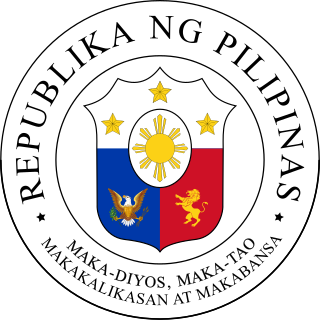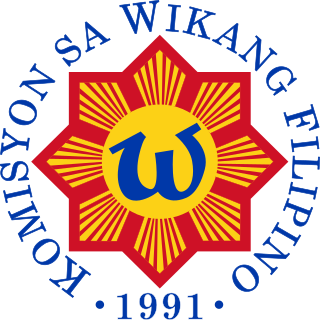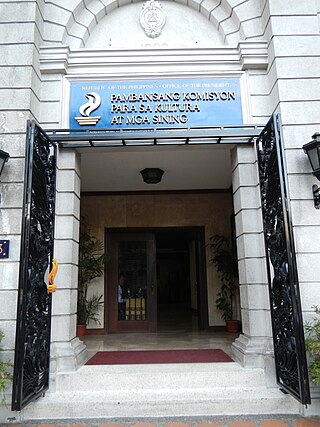
Filipino is a language under the Austronesian language family. It is the national language of the Philippines, and one of the two official languages of the country, with English. It is a standardized variety of Tagalog based on the native dialect, spoken and written, in Metro Manila, the National Capital Region, and in other urban centers of the archipelago. The 1987 Constitution mandates that Filipino be further enriched and developed by the other languages of the Philippines.

The president of the Philippines is the head of state, head of government and chief executive of the Philippines. The president leads the executive branch of the Philippine government and is the commander-in-chief of the Armed Forces of the Philippines.
Filipinoorthography specifies the correct use of the writing system of the Filipino language, the national and co-official language of the Philippines.

The Cabinet of the Philippines consists of the heads of the largest part of the executive branch of the national government of the Philippines. Currently, it includes the secretaries of 22 executive departments and the heads of other several other minor agencies and offices that are subordinate to the president of the Philippines.

The Commission on Higher Education is a government agency under the Office of the President of the Philippines. It is responsible for regulating and governing all higher education institutions and post-secondary educational programs in the country.

The Commission on the Filipino Language (CFL), also referred to as the Komisyon sa Wikang Filipino (KWF), is the official regulating body of the Filipino language and the official government institution tasked with developing, preserving, and promoting the various local Philippine languages. The commission was established in accordance with the 1987 Constitution of the Philippines.

The Department of Labor and Employment is one of the executive departments of the Philippine government mandated to formulate policies, implement programs and services, and serve as the policy-coordinating arm of the Executive Branch in the field of labor and employment. It is tasked with the enforcement of the provisions of the Labor Code.

The National Commission for Culture and the Arts of the Philippines is the official government agency for culture in the Philippines. It is the overall policy making body, coordinating, and grants giving agency for the preservation, development and promotion of Philippine arts and culture; an executing agency for the policies it formulates; and task to administering the National Endowment Fund for Culture and the Arts (NEFCA) – fund exclusively for the implementation of culture and arts programs and projects.

The National Assembly of the Philippines refers to the legislature of the Commonwealth of the Philippines from 1935 to 1941, and of the Second Philippine Republic during the Japanese occupation. The National Assembly of the Commonwealth was created under the 1935 Constitution, which served as the Philippines' fundamental law to prepare it for its independence from the United States of America.

The Second Philippine Republic, officially known as the Republic of the Philippines and also known as the Japanese-sponsored Philippine Republic, was a Japanese puppet state established on October 14, 1943 during the Japanese occupation of the islands.

The Philippines' Bureau of Plant Industry, is an agency of the Philippine government under the Department of Agriculture responsible for serving and supporting the Philippine plant industry sector.

The 1943 Philippine legislative election was held on September 20, 1943 to elect the 54 of the 108 members of the National Assembly of the Second Philippine Republic.
The National Assembly was the legislature of the Second Philippine Republic from September 25, 1943, to February 2, 1944.
The Preparatory Committee for Philippine Independence or the PCPI was the drafting body of the 1943 Philippine Constitution during the Japanese Occupation of the Philippines during World War II. The constitution was signed and unanimously approved on September 4, 1943, by its members and was then ratified by a popular convention of the KALIBAPI in Manila on September 7, 1943.

The Kapisanan sa Paglilingkod sa Bagong Pilipinas, or KALIBAPI, was a fascist Filipino political party that served as the sole party of state during the Japanese occupation. It was intended to be a Filipino version of Japan's governing Imperial Rule Assistance Association.

The Philippine Carabao Center an attached agency of the Department of Agriculture, was established at Science City of Muñoz in Nueva Ecija province in 1992 to breed and cross carabao based on high-yield Murrah buffalo in the Philippines as a multi-purpose animal that can be raised for milk, meat, hide, and draft.
The Constitution of the Philippines is the constitution or the supreme law of the Republic of the Philippines. Its final draft was completed by the Constitutional Commission on October 12, 1986, and ratified by a nationwide plebiscite on February 2, 1987.

Francisco "Soc" Aldana Rodrigo was a Filipino playwright, lawyer, broadcaster, and a Senator of the Philippines from 1955 to 1967.

The Office of the President of the Philippines, is an administrative, advisory, and consultative government agency that aids the president of the Philippines in performing their duty as head of state and chief of the executive branch of government.
















